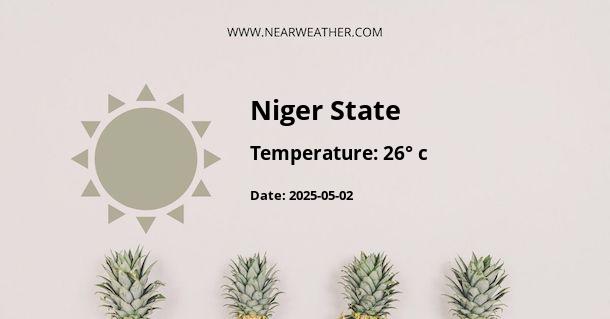Climate and Weather in Niger State, Nigeria
Niger State is located in the north-central region of Nigeria, covering an area of approximately 76,363 square kilometers. It is bordered by seven other states and is known for its diverse landscapes, including the Niger River, the Gurara Waterfalls, and the Jebba Hydroelectric Power Station. Understanding the climate and weather patterns of Niger State is essential for residents, tourists, and businesses operating in the area.
Geographical Factors
Niger State's climate is influenced by several geographical factors, including its location in the Sahel region, proximity to the Niger River, and its varying elevation. These factors contribute to the unique climate experienced in different parts of the state.
Sahel Region
Niger State is situated in the Sahel region, which is characterized by a semi-arid climate. The Sahel experiences a long dry season and a short rainy season. The state's proximity to the Sahel influences its overall climate, with hot and dry conditions prevailing for most of the year.
Niger River
The Niger River, one of the main geographical features of the state, plays a significant role in influencing the local climate. The river provides a source of moisture, which helps moderate temperatures and supports some agricultural activities along its banks.
Elevation
Niger State's elevation varies across its different regions, ranging from the low-lying areas along the Niger River to the higher plateaus in the north. Higher elevations generally experience cooler temperatures compared to the lower-lying areas.
Seasonal Weather Patterns
Niger State experiences two main seasons: the dry season and the rainy season. These seasons can vary in duration and intensity from year to year.
Dry Season (November to March)
The dry season in Niger State typically starts in November and lasts until March. During this period, temperatures are high, ranging from 30°C to 40°C (86°F to 104°F) during the day. Humidity levels are relatively low, contributing to the arid conditions. Rainfall is minimal or non-existent, and the skies are generally clear.
The Harmattan wind, a dry and dusty wind from the Sahara Desert, often blows across the state during the dry season. This wind can reduce visibility and lead to hazy conditions.
Rainy Season (April to October)
The rainy season in Niger State typically begins in April and lasts until October. During this period, the state receives the majority of its annual rainfall. Temperatures are slightly cooler, ranging from 25°C to 35°C (77°F to 95°F) during the day.
Rainfall patterns can vary across different regions of Niger State. The southern parts of the state, closer to the Niger River, generally receive higher amounts of rainfall compared to the northern areas. The intensity of rainfall can also vary, with occasional heavy downpours and thunderstorms.
Climate Variations Across Niger State
Niger State's climate varies across its different regions due to variations in elevation, proximity to water bodies, and local geography. The state can be divided into three distinct climatic zones: the Southern Zone, the Middle Zone, and the Northern Zone.
Southern Zone
The Southern Zone of Niger State, which includes areas along the Niger River, experiences a more tropical climate. The region receives higher amounts of rainfall compared to other parts of the state, with an average annual precipitation of around 1,200 to 1,600 millimeters (47 to 63 inches). Temperatures are slightly cooler due to the proximity to the river and increased cloud cover.
Middle Zone
The Middle Zone, located between the southern and northern parts of Niger State, experiences a transitional climate. Rainfall amounts are lower compared to the Southern Zone, ranging from 800 to 1,200 millimeters (31 to 47 inches) annually. Temperatures are higher compared to the Southern Zone but still moderate compared to the Northern Zone.
Northern Zone
The Northern Zone of Niger State, characterized by its higher elevation and distance from water bodies, experiences a more arid climate. The region receives less rainfall, averaging between 500 to 800 millimeters (20 to 31 inches) annually. Temperatures are higher compared to the other zones, with hot and dry conditions prevailing for most of the year.
Impacts on Agriculture and Economy
The climate and weather patterns in Niger State have significant implications for agriculture and the local economy. The state's diverse climate zones allow for the cultivation of a wide range of crops.
The Southern Zone, with its higher rainfall and fertile soils, supports the cultivation of crops such as rice, yam, cassava, and various vegetables. The Middle Zone, with its transitional climate, is suitable for the cultivation of crops like maize, millet, and sorghum. The Northern Zone, although more arid, still supports the growth of crops such as groundnuts and beans.
However, the variability in rainfall patterns can pose challenges for agricultural activities. Droughts and inconsistent rainfall can lead to crop failures and reduced yields, affecting the livelihoods of farmers in the state. The government and agricultural stakeholders have implemented various strategies to mitigate these risks, including irrigation systems and improved farming techniques.
In addition to agriculture, Niger State's climate also influences other sectors of the economy, such as tourism. The state's natural attractions, including the Niger River and the Gurara Waterfalls, attract visitors who enjoy outdoor activities and eco-tourism. Understanding the climate and weather patterns helps in planning and promoting tourism activities in the state.
Conclusion
Niger State experiences a semi-arid climate with distinct dry and rainy seasons. The geographical factors, including its location in the Sahel region, proximity to the Niger River, and varying elevation, contribute to the diverse climate zones across the state. Understanding these climate patterns is crucial for residents, tourists, and businesses operating in Niger State, as it influences agricultural practices, tourism activities, and overall planning for various sectors of the economy.
A - Niger State's Latitude is 10.000000 & Longitude is 6.000000.
A - Weather in Niger State is 25° today.
A - Climate Conditions in Niger State shows clear sky today.
A - Humidity in Niger State is 27% today.
A - Wind speed in Niger State is 6.8 km/h, flowing at 355° wind direction. today.
